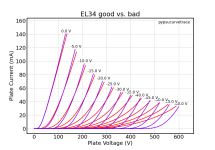It must be something with the tube itself. All other tubes worked fine using the very same socket. Is this something that happens as a result to aging? Gassy tube?
Maybe. You have a mu that is about right at high currents, but collapses at low currents, and the anode current is always greater than or about equal to the right value. That sounds like there is some extra conductive path between the anode and the rest, but it's not a linear one.
Is there any chance that it oscillates? Oscillations are the ideal way to get DC currents that make no sense at all.
Is there any chance that it oscillates? Oscillations are the ideal way to get DC currents that make no sense at all.
I've seen curves like that before online and with one of my own tubes. I don't know the cause but my suspicion was cathode material being redeposited on G1.
Is the other curve real ?; it looks very linear for an indirectly heated type.
Is the other curve real ?; it looks very linear for an indirectly heated type.
Yes, the other curve set is real. Both (all) tubes were measured in the very same way.
See https://mbrennwa.github.io/curvetracedata/EL34/
The "funny" tube is number 14.
I have seen oscillation with other tubes, but then the curves look rather erratic. Not smooth like in this case.
See https://mbrennwa.github.io/curvetracedata/EL34/
The "funny" tube is number 14.
I have seen oscillation with other tubes, but then the curves look rather erratic. Not smooth like in this case.
One possibility which was quite common with some of the early Russian and Chinese 300B tubes is that there is a path between the plate and cathode that has no grid wires in it. Some of these early tubes had grid wire windings that did not go all the way to the top insulator leading to a path without grid control. Here a grid voltage of -100 volts still let a few mA flow from cathode to plate. This is more pronounced at low current levels since a few (3 to 5 mA) will not be noticed at plate currents in the 80 to 100 mA range, but it's obvious when the tube should be cut off.
I don't know much about the history of this tube except that it looks like "Mullard xf2" type EL34. Misalignment, falls, gas leaks, whatever... it's a dud! I just thought it's interesting to learn what the reason(s) behind such behavior might be. Thanks everyone for your thoughts!
- Home
- Amplifiers
- Tubes / Valves
- Tube does not want to turn off -- why?

